Scientific research conducted by
‘Maharshi Adhyatma Vishwavidyalay’ using PIP technology
The spiritual state of the individual can be comprehended from the vibrations emitting from his/her photo when it was clicked. If a comparative study of the vibrations emitting from two photos of an individual, one before commencing spiritual practice and the other after considerable spiritual progress (after increase in his/her Sattva component) is done, we can comprehend the changes the individual has undergone at the spiritual level. Such aspects about an individual (which can be understood from his/her photo) can also be understood about a Nation from its map. Over the past 100 years, Bharat has witnessed plenty of political changes. Consequently, there have been plenty of changes in Bharat’s map. To study if there have been any changes at the spiritual level in the condition of Bharat, an experiment was conducted in Sanatan’s Ramnathi Ashram on 21.10.2016. The experiment involved a scientific comparative study of the map of ‘Akhand Bharat (Note 1)’ and the map of ‘contemporary Bharat (Note 2)’ on the environment. In this experiment PIP (Polycontrast Interference Photography) technology, which is useful in studying the aura of objects and individuals, was used. Given ahead are the observations of the experiment and their analysis.
Note 1 – Map of ‘Akhand Bharat’ : The undivided outline of Bharat (Before 1920) is termed ‘Akhand Bharat’. Tibet, Nepal, Bhutan, Myanmar, Bangladesh, Sri Lanka and Pakistan were then parts of ‘Akhand Bharat’. The map shown here is of ‘Akhand Bharat’.
Note 2 – Map of contemporary Bharat : After 1920, ‘Akhand Bharat’ witnessed many partitions. As a result, Tibet, Nepal, Bhutan, Myanmar, Bangladesh, Sri Lanka and Pakistan separated from Bharat. The map shown here is of contemporary Bharat
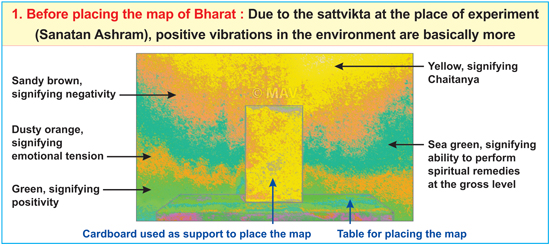
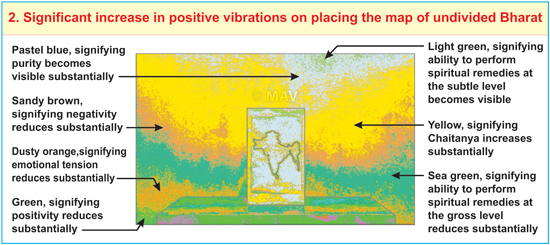
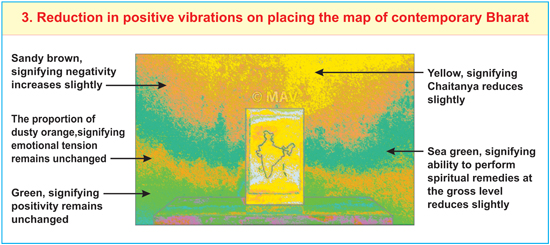
1. Nature of the experiment
In the experiment, photos of the environment were taken using PIP technology before placing the photos on the table. This is called the ‘Baseline reading’. Then, one by one photos of ‘Akhand Bharat’ and ‘contemporary Bharat’ were placed on the table and PIP photos were taken separately. Upon comparing the photos, it was possible to study the effect of the vibrations emitted by the samples on the environment.
Note for readers
Due to shortage of space we have given the common features of PIP article on goo.gl/TwBxhe (Please note that some letters are in Caps) – The purpose of using scientific equipment or technology to study the spiritual uniqueness of samples in the experiment, PIP technology has the facility of displaying positive and negative vibrations of objects through colours, precautions taken during the experiment, Baseline reading (the original aura of the environment), principle underlying the phenomenon of change in the proportion of colours in the aura of the sample, information on the colours in the aura, colours that represent superior level positive vibrations in a PIP photo is considered a good sign and uniqueness of colours in a PIP photo have no relation to spiritual uniqueness of colours in reality.
2. Analysis of the observations
2A. Baseline reading – Due to the sattvik environment in the Ashram, the proportion of positive vibrations recorded was higher
In Kaliyug, in an ordinary premises, the emission of negative vibrations is higher than that of positive vibrations. In the aura of the Baseline reading (meaning, the aura of the environment) the proportion of positive vibrations was 68% and that of negative vibrations was 32%. The experiment was conducted in the highly sattvik Sanatan Ashram and hence, the extent of positive vibrations is higher in the aura during the Baseline reading as well.
2B. The map of ‘Akhand Bharat’ emitting large amount of vibrations of Chaitanya (Divine consciousness) and Holiness into the environment
In the aura of ‘Akhand Bharat’, the extent of positive vibrations was 80% and that of negative vibrations was 20%. When compared with the Baseline reading of the environment, the extent of positive vibrations in the aura of map of ‘Akhand Bharat’ was higher by 12%. Besides, the yellow that signifies Chaitanya and the pastel blue that signifies Holiness were seen in higher proportion in this aura; so also, the light green that has spiritual healing ability at the subtle level was visible to a lesser extent. From this we can conclude that many spiritually beneficial vibrations are emitted into the environment from the map of ‘Akhand Bharat’.
2C. The extent of emission of positive vibrations from the map of contemporary Bharat is lesser by 18% than that of ‘Akhand Bharat’
The extent of positive vibrations in the aura of the map of contemporary Bharat is 62% and that of negative vibrations is 38%. When compared with the positive vibrations in the aura of the map of ‘Akhand Bharat’, those in the map of contemporary Bharat had reduced by 18%. In the aura of the map of contemporary Bharat, among the colours that denote positive vibrations the yellow of Chaitanya was seen to a lesser extent and the pastel blue and light green that signify superior positive vibrations were not visible. From these observations we can conclude that emission of beneficial vibrations from the map of contemporary Bharat is very less when compared with the vibrations emitting from the map of ‘Akhand Bharat’.
The spiritual analysis of Points ‘2B’ and ‘2C’ is given in Points ‘3A’ and ‘3B’.
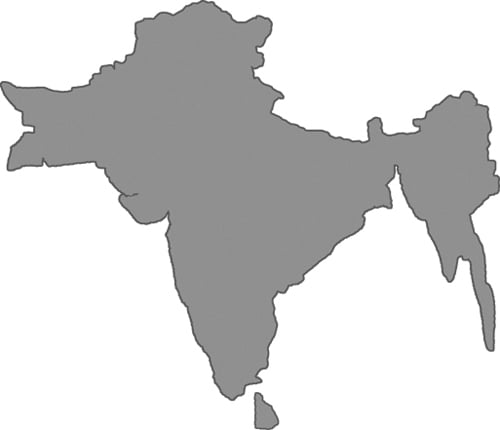

3. Spiritual Analysis
3A. When compared with contemp-orary Bharat, the number of pilgrimage centres in ‘Akhand Bharat’ was more, so also, the subjects then abided by Dharma and performed spiritual practice that made the environment sattvik
In ‘Akhand Bharat’, the number of pilgrimage centres (which were a source of Chaitanya and Holiness) was more and hence, the environment was continuously purified. The society then abided by Dharma to a greater extent and performed spiritual practice and hence, the extent of sattvikta was higher. Politically, Bharat was under foreign rule then; however, most people were intensely patriotic and dedicated to Dharma. Most people then were ready to sacrifice their own happiness and their life for the Independence of Bharat. Then the extent of crimes, corruption, as also the extent of pollution of natural resources such as water-air, was less when compared with the present times. The combined effect of all this was that the map of ‘Akhand Bharat’ emitted far more spiritually beneficial vibrations.
3B. There is reduction in sattvikta of the environment due to the present-day politicians who do not teach subjects to help people abide by Dharma and perform spiritual practice
Bharat has been partitioned many times since 1920 and as a result, some of the important pilgrimage centres have been separated from Bharat. This has become contemporary Bharat’s spiritual loss. Contemporary Bharat is independent politically; but, most people today have become so self-centred that giving priority to their own happiness has become their attitude. Politicians have declared Bharat a ‘Secular’ Nation. As a result, this Nation does not have the foundation of Dharma now. Since politicians did not teach spiritual practice to the society after Independence, there has been a spiritual as well as moral decline of the society. Today, crime and corruption have reached their zenith. Urbanisation has resulted in pollution of natural resources such as water-air. The combined effect of all this is a reduction in the emission of spiritually beneficial vibrations from the map of contemporary Bharat. ?
– Mr. Rupesh Laxman Redkar, Maharshi Adhyatma Vishwavidyalay, Goa.
E-mail : [email protected]
Urbanisation has resulted in reduced emission of spiritually beneficial vibrations from the map of contemporary Bharat !
The map of ‘Akhand Bharat’ emits large amount of vibrations of Chaitanya and Holiness into the environment !

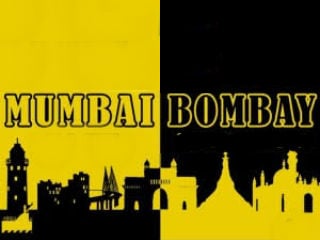 The need to change non-sattvik names of some cities such as Bombay, Aurangabad, and re-naming...
The need to change non-sattvik names of some cities such as Bombay, Aurangabad, and re-naming...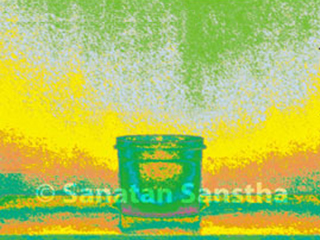 Effects on the environment of a pot emitting fragrance
Effects on the environment of a pot emitting fragrance Spiritual Puzzle
Spiritual Puzzle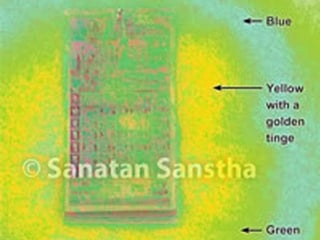 Spiritual importance of ‘Sanatan Almanac’
Spiritual importance of ‘Sanatan Almanac’